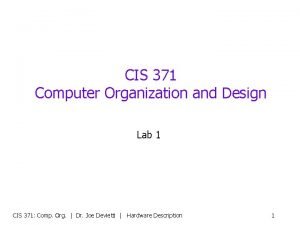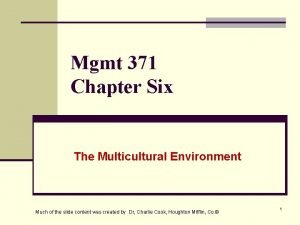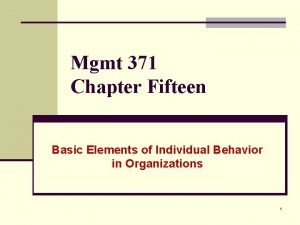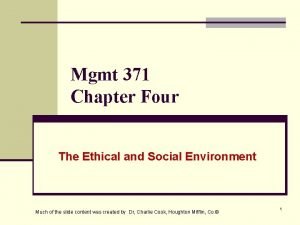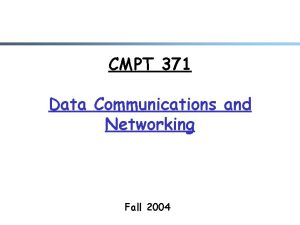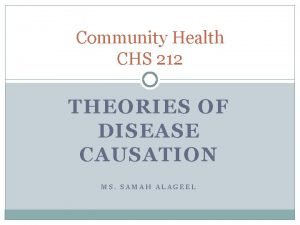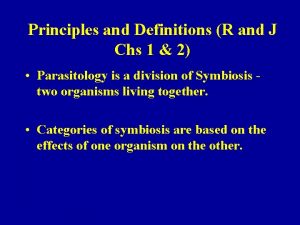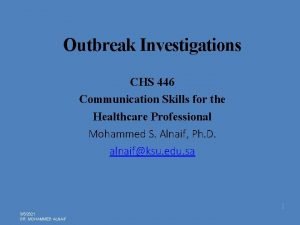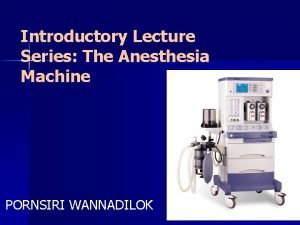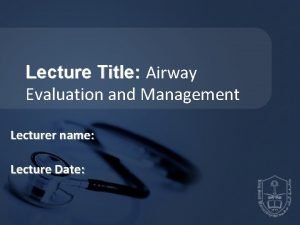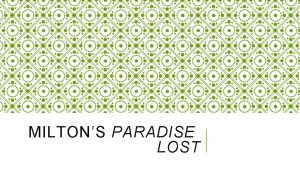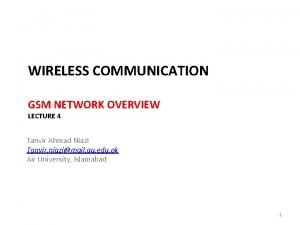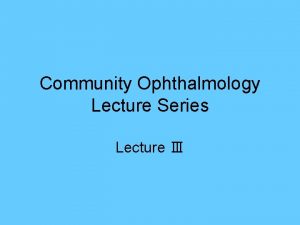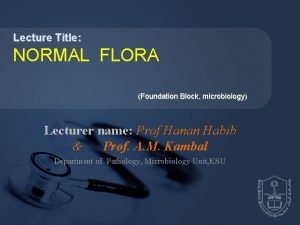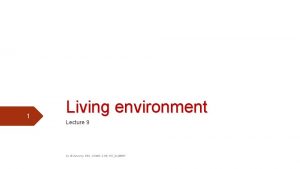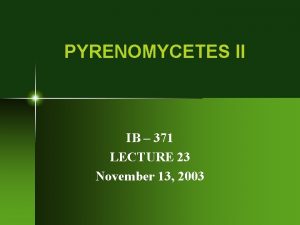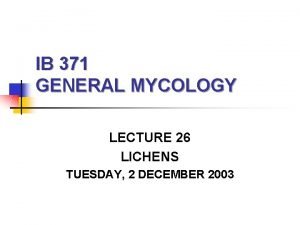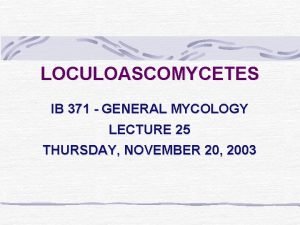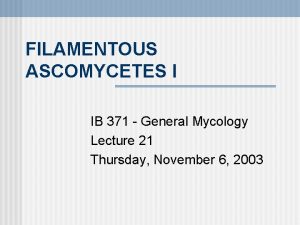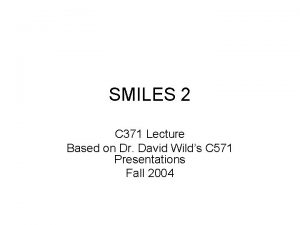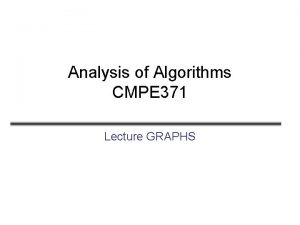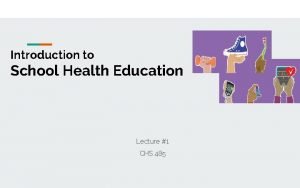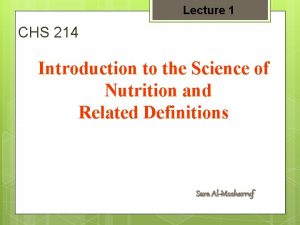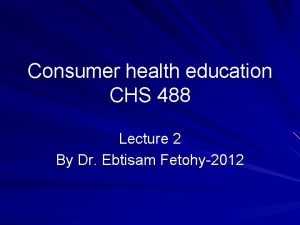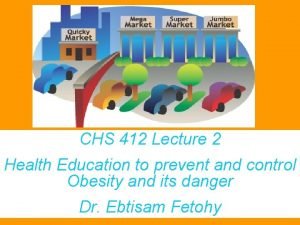Lecture 5 Dr IEcheverry CHS 371 2 nd





































- Slides: 37

Lecture 5 Dr. IEcheverry - CHS 371 _ 2 nd 3637 Food

• Define food safety • Define food contamination • Identify the determinants of safe food • Identify sources of food contaminants and their effects on human health • Identify methods to prevent food contamination Dr. IEcheverry - CHS 371 _ 2 nd 3637 Objectives

Introduction What is food? Any substance (solid or liquid) consumed by living organisms for the purpose of nutrition and survival, and that their bodies use to derive the elements necessary for growth and development. Expectation of food to be good for you: Provide nourishment and Be free of any materials that can be harmful to health. Dr. IEcheverry - CHS 371 _ 2 nd 3637 •

Food Contamination • Substances that have not been intentionally added to food. • May be the result of environmental contamination or may be introduced in foods during production, packaging, transport or holding. Food Contaminants. http: //ec. europa. eu/food/chemicalsafety/contaminants/index_en. htm Food contamination • In raw food or in cooked food improperly handled, heated or stored; cross-contamination from raw foods to cook foods, improper hand washing, pests. • Negative impact on the quality of food and a risk to human health. Dr. IEcheverry - CHS 371 _ 2 nd 3637 Food contaminants

Categories of Food Contaminants Food hazards Microorganisms - Bacteria, viruses, parasites, and fungi. Food allergens. • Physical Stones, animal bones, pieces of glass or metal, other solid foreign materials. Food Contaminants. http: //ec. europa. eu/food/chemicalsafety/contaminants/index_en. htm • Chemical Pesticides, herbicides, fertilizers Heavy metals, other chemical substances. Toxins – plants, animals. • Nutritional Inadequate amounts (excessive or deficient) of nutrients that can lead to disease. Dr. IEcheverry - CHS 371 _ 2 nd 3637 • Biological

Biological Hazards • Spore-forming • bacteria – able to Clostridium perfringens - meat dishes stored after cooking with insufficient cooling and reheating (stored at 5 -60ºC long enough to facilitate bacterial growth). survive temperature extremes and for long periods. • Bacillus cereus – pasteurized milk Found in vegetables, spices, contaminated during processing. honey, meat and milk of animals • Clostridium botulinum – that ate the spores. unpasteurized (raw) honey containing spores as a risk for infants under 1 year of age. Infant botulism and spores in soil and dust. Dr. IEcheverry - CHS 371 _ 2 nd 3637 Bacteria

Biological Hazards Bacteria Destroyed by heat – cooking, pasteurization. E. coli Fecal contamination. Undercooked beef, raw vegetables (in contact with manure), improper hand washing. Kidney hemorrhage as a complication – possibly death. Listeria Manure-contaminated soil and water. Meats raw and cooked, cold cuts, vegetables, milk, cheese. Contaminated processing equipment and different foods. Dr. IEcheverry - CHS 371 _ 2 nd 3637 • Non-spore-forming bacteria

Biological Hazards Bacteria • Non-spore-forming bacteria Raw poultry and eggs, raw meat and milk. Other foods during handling or processing. At higher risk are pregnant and nursing women, infants, elderly, immunocompromised. Dr. IEcheverry - CHS 371 _ 2 nd 3637 Salmonella

Biological Hazards Viruses Need living cells to survive. Animal or human cells. Small amounts can cause illness in susceptible individuals. • Norovirus – gastroenteritis. Droplet, air-borne, fecal-oral transmission. Severe dehydration in the very young, elderly, and the immunocompromised. Highly contagious – up to two weeks after recovery. • Hepatitis A virus – infectious hepatitis. Complications in people with liver disease. Fecal-oral contamination. Poor hand-washing and contaminated food/water. Manure-contaminated water and raw vegetables. Dr. IEcheverry - CHS 371 _ 2 nd 3637 •

Dr. IEcheverry - CHS 371 _ 2 nd 3637

Biological Hazards • Small animals that live in or on a living host. • Fecal-oral contamination. • Roundworms in fish. Can attach to the throat, stomach or intestines. • Cyclospora in fruits and vegetables. Dr. IEcheverry - CHS 371 _ 2 nd 3637 Parasites

Biological Hazards Food allergens Substances in food that can cause the immune system of sensitive people to overreact. Very small amounts are enough. Usually proteins. Symptoms occur shortly after consumption. Life-threatening reaction – anaphylaxis. • Read food labels and avoid cross-contamination. Dr. IEcheverry - CHS 371 _ 2 nd 3637 • Major food allergens

Chemical Hazards Intentional or accidental presence in foods. • Toxins Natural – plants and animals • Pesticides, herbicides, veterinary drugs, antibiotics in animal feed, food additives, industrial byproducts, heavy metals. Pesticides and herbicides Fruits and vegetables. Children at greater risk. Antibiotics and other drugs Meat, milk, chicken, eggs. Antibiotic-resistant microbes. Organic vs. conventional foods Food additives Substances added to food to achieve a specific purpose. Risk to consumers if in excess, or in cases of food sensitivities or allergies. Colors, flavor enhancers, preservatives. Dr. IEcheverry - CHS 371 _ 2 nd 3637 •

Chemical Hazards • • • Plastic used in baby bottles, water bottles, liner for metal food cans, plastic food storage containers. Links to cardiovascular disease, type 2 diabetes, liver enzyme abnormalities, endocrine disruptor. Reduce exposure by Eating less canned foods. Using BPA-free baby bottles and plastic containers. Phthalates • Make plastics flexible. • Found in fatty foods, milk, fish, meat and oils. • Exposure by ingestion, inhalation and skin absorption. Metabolized and excreted in urine and feces. Bioaccumulation in humans not clear. Affect the developing fetus. Reproductive issues in males. Brain development issues in females. Dr. IEcheverry - CHS 371 _ 2 nd 3637 Bisphenol A (BPA)

Chemical Hazards Toxins from fish and shellfish Not destroyed by heat. Algae and plankton toxins passed onto seafood. Types of poisonings: Paralytic shellfish poisoning – muscles, respiratory and CV symptoms. Diarrheic shellfish poisoning – GI symptoms. Neurotoxic shellfish poisoning – nervous symptoms. Ciguatera fish poisoning –caused by biomagnification of toxins produced by microscopic sea plants called dinoflagellates. GI, neurological and CV symptoms. Dr. IEcheverry - CHS 371 _ 2 nd 3637 • Amnesic shellfish poisoning – GI and neurological symptoms, shortterm memory loss.

Points of contamination • Growing • Harvesting, holding/storage • Transport • Processing • Packaging • Distribution • Preparation • Consumption Dr. IEcheverry - CHS 371 _ 2 nd 3637 Polluted soil, water, air.

Foodborne diseases • • Illnesses caused by consuming contaminated food or drink. The food may be contaminated by microorganisms, their toxins, or chemical or physical substances. Oral route of entry into the gastrointestinal tract. First symptoms usually GI. • Some severe cases involve organs other than the GIT. Common symptoms • Nausea, vomiting, diarrhea, abdominal pain. • Headache, fever, dehydration. • No or mild flu-like symptoms in healthy adults. Dr. IEcheverry - CHS 371 _ 2 nd 3637 •

Foodborne diseases 1. Type of contaminant – biological, chemical, physical. 2. Amount of contaminant in the food consumed. 3. Amount of food consumed. 4. Individual health status. Most at risk • Infants, young children, the elderly, pregnant and nursing women. • Immunocompromised patients – life-threatening. HIV, cancer, or on immune suppressors (organ transplant). Can become violently ill with smaller amounts of pathogens. Dr. IEcheverry - CHS 371 _ 2 nd 3637 Factors affecting the symptoms

Foodborne diseases Onset time Amount of time between eating the contaminated food and the first symptoms of illness. • Factors Age. Health status. Weight. Amount of contaminant. Type of contaminant. Dr. IEcheverry - CHS 371 _ 2 nd 3637 •

Foodborne diseases • • Foods that can support the rapid growth of pathogenic microorganisms. Proper handling and storage is needed. Examples: Examples of foods: High protein, low acid, high moisture, protein-rich foods provide an ideal environment for pathogenic bacteria. Bacteria need nutrients to survive. Cooking time/temperature. Meat, poultry, milk, fish and seafood. Plant foods that have been heat-treated. Raw seed sprouts. Dr. IEcheverry - CHS 371 _ 2 nd 3637 Potentially hazardous foods

Food contamination and spoilage Contamination vs. Spoilage both, there are pathogens in the food. § Depending on the pathogen, the appearance, smell or taste of the food may not change. § Contaminated food may not appear dangerous to eat. § Spoiled food will show changes in the smell, appearance and/or taste, indicating that the food is not safe to eat. § Contaminated food may not show signs of spoilage. § Fruits – fungi. § Vegetables – bacteria and fungi. Dr. IEcheverry - CHS 371 _ 2 nd 3637 § In

Preventing food contamination No zero risk. Food can never be entirely safe. Pathogens may contaminate food at any time. • • Common sources of contamination (Air, water and soil). Some man-made pollutants are common in the environment and difficult to avoid or to determine source of contamination. • Foodborne disease prevention and education provided to: Food growers, handlers and consumers. Main factors contributing to foodborne outbreaks: Improper storage/holding temperatures. Improper preparation/cooking time or temperature. Improper personal hygiene in food handlers. Contaminated equipment. Dr. IEcheverry - CHS 371 _ 2 nd 3637 •

Dr. IEcheverry - CHS 371 _ 2 nd 3637 Preventing foodborne diseases

• Hand washing – simplest, most effective way to prevent diseases. • Hand washing with soap and water. • Hand sanitizers are not a substitute for hand washing. • Clothing, gloves and hair nets. • No eating, smoking or drinking in food preparation areas. • People in charge of food preparation must be in good health. • Clean food preparation area surfaces and implements to avoid crosscontamination • Transfer of pathogens between clean and contaminated surfaces, foods, utensils during storage or preparation. Raw to cooked foods. Cutting boards or utensils. Soiled hands or counters. Dr. IEcheverry - CHS 371 _ 2 nd 3637 Preventing foodborne diseases

Dr. IEcheverry - CHS 371 _ 2 nd 3637 Preventing foodborne diseases Frumkin H. Environmental Health: From Global to Local. 2 nd Edition. 2010. Jossey-Bass.

Preventing foodborne diseases • Cook food thoroughly. • Avoid consuming raw animal foods. • • Cook chicken to internal temperature of 75ºC/15 seconds. Cook ground beef to internal temperature of 72ºC. Food safety. http: //www. foodsafety. gov/keep/types/meat / USDA. Beef from farm to table. Food sources to avoid • Shellfish and fish from polluted waters. • Agricultural products and polluted soil or water. • Foods prepared from raw animal products – milk or meat. • Foods improperly handled or stored. Dr. IEcheverry - CHS 371 _ 2 nd 3637 Cooking Temperature

Preventing foodborne diseases • Temperature danger zone: 5 -60ºC. • Keep hot foods hot and cold foods cold or do not keep it. Hot foods > 60ºC. Cold foods < 5ºC. • During heating or cooling of foods minimize the time the food spends in the temperature danger zone. Chill or heat quickly. Avoid repeated cycles of heating and chilling. Do not thaw food at room temperature. Dr. IEcheverry - CHS 371 _ 2 nd 3637 Holding temperatures

Preventing foodborne diseases • Use of ionizing radiation to destroy pathogenic bacteria, insects, parasites, and fungi. Extends shelf-life and improves safety of foods. Not a substitute for food hygiene practices. Viruses resist irradiation at the levels approved. www. fda. gov/Food/Resources. For. You/Consumers/ucm 261680. htm • Most of the radiation passes through the food without being absorbed. The amount that is absorbed destroys any pathogenic organisms and slows down fruit and vegetable ripening. Dr. IEcheverry - CHS 371 _ 2 nd 3637 Food irradiation

Preventing foodborne diseases Food irradiation • Beef, seafood (lobster, shrimp, and crab), fresh fruits and vegetables, lettuce and spinach, shellfish (oysters, clams, mussels, and scallops), poultry, seeds for sprouting shell eggs, spices and seasonings. www. fda. gov/Food/Resources. For. You/Consumers/ucm 261680. htm Dr. IEcheverry - CHS 371 _ 2 nd 3637 FDA approved foods for irradiation in the USA

• There is an increased number of emerging pathogens because of changes in how food is produced and distributed. Mass production, food imports. Pathogens spreading to places far away from their origin. Increased antibiotic resistance. • Lack of rules, regulations, surveillance and monitoring systems or food safety or poor implementation of them. • Lack of educational programs to increase awareness among consumers. Dr. IEcheverry - CHS 371 _ 2 nd 3637 Factors that contribute to the spread of foodborne diseases

Genetically modified foods (GMOs) Genetically-engineered, transgenic foods. • Rice modified to have less glutelin resulted in high levels of a protein with high allergenicity and lower nutritional value. Rice modified to have β-carotene resulted with high levels of other carotenoids instead. Bacterial genes – corn, potatoes, and cotton. Herbicide-tolerant genes – soy and corn. Increased use of specific herbicides or pesticides. Harm to humans and environment biodiversity. • Genetically modified organisms can escape into natural ecosystems and disrupt biodiversity. Genetically Modified Foods. http: //www. chgeharvard. org/topic/genetically-modified-foods Unexpected changes in nutrients. • Will GMOs solve world food problems? Poor countries – war, lack of infrastructure. Dr. IEcheverry - CHS 371 _ 2 nd 3637 •

Organic vs. conventional foods Nutritionally No consistent differences seen in nutrient content. Varies with food type. • Higher vitamin C concentrations in organic leafy vegetables, such as spinach, lettuce. • No difference in protein or fat content of milk. Organic milk may contain higher levels of antioxidants and omega 3 fatty acids. • Organic plant foods had lower nitrate content and higher phosphorus content. Nitrates and increased risk of gastrointestinal cancer, and methemoglobinemia in infants. Dr. IEcheverry - CHS 371 _ 2 nd 3637 •

Organic vs. conventional foods Environmentally Organic foods and lower risk of pesticide, herbicide or synthetic fertilizers contamination. Lower levels of pesticide residues in children’s urine. But not pesticide-free. • Organically raised animals and reduced use of drugs. Antibiotics, hormones, steroids. Reduced exposure to antibioticresistant bacteria. • Increases nutrient recycling and enhances and protects biodiversity. Crop rotation. • No synthetic fertilizers, pesticides or herbicides. Dr. IEcheverry - CHS 371 _ 2 nd 3637 •

Food production and the environment What and how much we eat impacts our health and the health of the environment. Changing diets, obesity and related diseases. Excess of animal protein consumption. Cattle growing, overfishing. Less biodiversity. Rice, corn and wheat as main staples. Biodiversity Soil health Water resources Food miles Growing, Harvesting, Distribution and the range of foods available Dr. IEcheverry - CHS 371 _ 2 nd 3637 •

• Malnutrition is caused by nutrient imbalance even if the caloric content in the diet is adequate. Nutrient imbalance occurs because of inadequate diet or because of a health condition that interferes with digestion or absorption of nutrients. Obesity is a form of malnutrition called ‘overnutrition. ’ • Undernourishment is caused by insufficient food and nutrients, leading to diseases associated with nutritional and calorie deficiencies. Too little food to provide the necessary nutrients for normal growth and development. Dr. IEcheverry - CHS 371 _ 2 nd 3637 Food production and the environment

• Frumkin H. Environmental Health: From Global to Local. Second Edition. 2010. Jossey-Bass. John Wiley and Sons, Inc. • Middlecamp C et al. Chemistry in Context: Applying Chemistry to Society. Seventh Edition. A Project of the American Chemical Society. 2012. Mc. Graw-Hill Publishers. • Genetically Modified Foods. http: //www. chgeharvard. org/topic/genetically-modifiedfoods • Tuomisto, H. L. et al. 2012. Does organic farming reduce environmental impacts? – A meta-analysis of European research. http: //www. sciencedirect. com/science/article/pii/S 0301479712004264 • American Academy of Pediatrics. 2012. CLINICAL REPORT Organic Foods: Health and Environmental Advantages and Disadvantages. http: //pediatrics. aappublications. org/content/130/5/e 1406. full. pdf • Open Learn Works. Hygiene and Environmental Health Module: 8. Food Contamination and Spoilage. The Open University. Accessed on 2 -27 -16. http: //www. open. edu/openlearnworks/mod/oucontent/view. php? id=194 Dr. IEcheverry - CHS 371 _ 2 nd 3637 References

Additional reading Benbrook, C. Nutrition Action Health Letter. October 2012. CSPI. Going Organic: What's the payoff? http: //www. cspinet. org/nah/articles/goingorganic. html Dr. IEcheverry - CHS 371 _ 2 nd 3637 •
 Cis 371
Cis 371 Mgmt 371 final exam
Mgmt 371 final exam Intel 4004 transistor count
Intel 4004 transistor count 284 371 in word form
284 371 in word form 6 371
6 371 Mgmt 371
Mgmt 371 Mgmt 371
Mgmt 371 Top dop
Top dop 80 en yakın onluğa yuvarlama
80 en yakın onluğa yuvarlama Cmpt 371
Cmpt 371 Cis 371
Cis 371 Chs investigations
Chs investigations Example of chs theories
Example of chs theories Chs.edf.school
Chs.edf.school Creative house scaffolding
Creative house scaffolding Chs module
Chs module Chs hcpss
Chs hcpss Chs vs ibs
Chs vs ibs J'chs 2
J'chs 2 Budowa dysku hdd
Budowa dysku hdd St roberts catholic high school
St roberts catholic high school Chs statistics
Chs statistics Chs investigations
Chs investigations Baseball parent meeting agenda
Baseball parent meeting agenda 01:640:244 lecture notes - lecture 15: plat, idah, farad
01:640:244 lecture notes - lecture 15: plat, idah, farad Oblique sinus
Oblique sinus Anesthesia machine lecture
Anesthesia machine lecture Recording business transactions
Recording business transactions Lecture title
Lecture title Paradise lost milton summary
Paradise lost milton summary English language lecture
English language lecture Lecture 4
Lecture 4 Gsm network overview
Gsm network overview Ophthalmology lecture
Ophthalmology lecture Lecture title
Lecture title Elemen urban design
Elemen urban design The parsec lecture tutorial answers
The parsec lecture tutorial answers Fluorocein
Fluorocein
